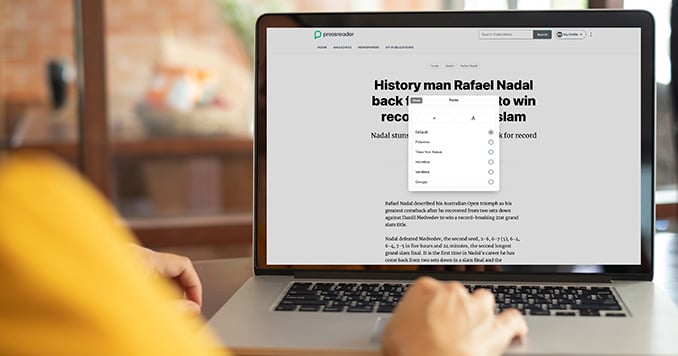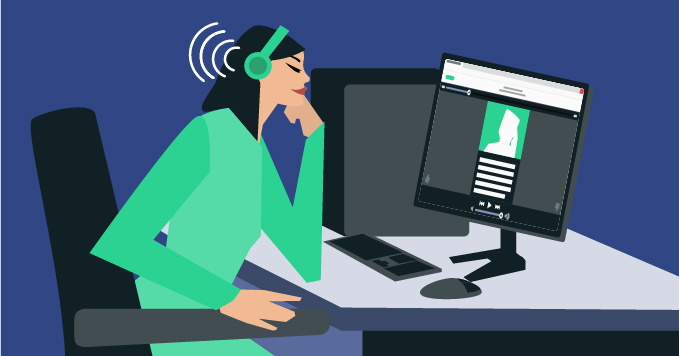Thousands of libraries around the globe now offer PressReader to their valued patrons, enabling them to access content from thousands of the world's best publications.The libraries we work with tell us they love PressReader for a wide variety of reasons. Here are just five:
1. We help them serve diverse populations
From large urban libraries to small ones in rural areas, librarians at institutions of all kinds — including public and academic libraries — must be prepared to meet the needs of a wide variety of patrons.
A library that offers PressReader is able to provide patrons with access to more than 7,000 high-quality periodicals from around the world, covering topics that range from business, science and technology to art and design, and from breaking news to sports and entertainment.
Because PressReader’s catalog includes titles from more than 120 countries in over 70 different languages, it can help readers from all over the world stay connected to what’s happening locally and back home.
Tools to empower
At colleges and universities, students and faculty require tools that will empower them to access the right information to enable their research or academic work — and they count on that information being accessible and up-to-date. For these library users, PressReader can be an indispensable resource.
Whether they’re researching a rapidly developing topic or just trying to keep up with the latest news stories or sports headlines, PressReader users can always find the most recent edition of publications like The Guardian, Newsweek, The Globe and Mail, Forbes, Discover, National Post, Rolling Stone, The Boston Globe, El Pais and thousands of others. And if they’re looking for articles from a past issue of a newspaper or magazine, they’ll be able to search PressReader’s catalog by date.
2. We’re accessible
We know how important it is for libraries to be able to provide accessible services to patrons with disabilities. We are also aware that libraries around the globe are compelled to abide by standards set by their national associations or government bodies. For web resources and digital tools, these standards are often rooted in the Web Content Accessibility Guidelines (WCAG), a set of recommendations developed by the World Wide Web Consortium (W3C).
Developed under the W3C’s Web Accessibility Initiative, the WCAG includes technical specifications for improving the accessibility of web content, websites and web applications on various devices, including desktop computers and mobile phones. These guidelines are meant to address auditory, cognitive, neurological, physical, speech and visual disabilities.
Access for everyone
At PressReader, one of our mandates is to make sure that everyone can access content that includes top newspapers and magazines from around the world — and we mean everyone. That’s why we developed PressReader Accessibility, a set of features (designed to meet the latest WCAG criteria) that make it easier for individuals with various accessibility needs to read the content available on our platform.
These features include:
-
Keyboard navigation. Integrated keyboard navigation allows readers to browse publications with just a few taps — making it simple for those with motor disabilities or vision impairment. They can switch from one article to the next using the TAB and ENTER keys.
-
Font enhancement. Flexible font size is key to making content accessible to everyone. We’ve made it possible for readers to enlarge or shrink the font size on our publications to fit their unique needs.
-
Article view. PressReader Accessibility extracts text from the original newspaper or magazine digital replica and presents it in a format that’s simple to navigate. Publications break down into sections for easy reading, so readers don't need to scan through an entire page to find what they're looking for; they can focus on one article at a time to reduce distractions.
-
Compatibility. Visually impaired readers rely on screen readers to convert digital text into spoken language— allowing them to listen to the content on the screen. PressReader Accessibility is compatible with popular screen readers on the market. It’s also available through the internet browser on desktop and mobile devices.
3. Libraries can share their own content
One more reason librarians love PressReader is that it’s more than just a way to give patrons free access to the world’s best newspapers and magazines. With PressReader’s Self-Pub feature, libraries can also share their own content on our platform. By digitizing and uploading their own newsletters, announcements and other publications to the front page of PressReader, libraries are able to further engage with their users.
Recently, we heard from Almada Public Library in Almada, Portugal, which serves a population of 24,000 library patrons, ranging from kids to seniors.
The library publishes a number of publications related to its local municipality. Many of these are still being produced as print editions, but it is now possible for the library to save a significant amount of time and money in distributing these publications digitally.
A simple yet effective way to connect
Using Self-Pub, Almada Public Library is able to publish up to five publications at a time. “We can publish and make available municipal publications,” librarian Armando Correia told us. “For instance, publications about the county's history or the municipalities’ cultural calendar — and, of course, the news of the municipalities.”
With Self-Pub, patrons are greeted by the library’s latest content as soon as they open the PressReader app, ensuring they see important updates and news before they begin browsing the catalog of titles. The simple drag-and-drop tool is easy for library staff and gentle on budgets, making it a simple yet effective way to connect with library users.
4. PressReader helps build patron loyalty
During the height of COVID-19 lockdowns, when a visit to a brick-and-mortar branch was not an option, many patrons continued to make use of their local public libraries’ online resources from the comfort and safety of their own homes. Accessed remotely through the library’s own portal, digital tools such as PressReader became an important way for libraries to ensure that their users could find essential news stories and up-to-date information from global, trusted sources.
Think of it as a form of branding: providing patrons with unlimited access to daily news and critical content on a regular and ongoing basis helped libraries position themselves in patrons’ minds as valuable information resources. With physical branches reopened, avid readers have two ways of accessing PressReader. Patrons who visit in person can log in using the library’s WiFi. Those off-site can use whichever secure authentication method their library has chosen to sign in and then access the catalog using their PressReader account on their own device.
Trustworthy global sources
With PressReader, librarians provide trustworthy global sources to local communities. This can be a key aspect of building media literacy and critical reading skills — not to mention an opportunity to broaden readers’ horizons and look at the world and its issues from diverse viewpoints.
Take it from Peter Bladlund, IT & Studies Librarian at Vimmerby Public Library in Sweden: “The possibility for so many people with different international backgrounds to read current newspapers and magazines in their own languages is to me an almost priceless feature, because far from everyone can afford a subscription to even one physical version of what PressReader can provide. In a small town like ours, it’s also practically impossible to find international newspapers and magazines without having to order them — even then you might get them a day or more after the publishing date!”
5. PressReader supports media literacy
Because they provide the community with access to a wide range of reading materials and resources, librarians are in a position to promote the crucial skills of media literacy and to help educate patrons to recognize false or harmful information.
PressReader has long been a proponent of information literacy. That’s because, as we explored in our recent campaign on the subject, critical thinking is an essential skill for citizens in a functioning, democratic society.
Knowledge is power
We believe that knowledge is power, and that it’s important for readers to engage with ideas from across the political spectrum. Librarians can do their by offering free access to trusted journalism with tools like Pressreader, which can open patrons’ eyes to the wide range of thoughts, ideas and perspectives to be found through high-quality journalistic stories.
And because we also recognize that media literacy is a crucial life skill for the next generation of leaders, we decided to create a Media Literacy Toolkit, a resource that librarians can use to introduce critical thinking to young people through interactive activities.
The Media Literacy Toolkit was designed to be used in conjunction with PressReader's catalog of newspapers and magazines, which can also help librarians provide younger patrons with an introduction to the library’s other digital resources and services.
Learn more about how libraries partner with PressReader to give their diverse patrons access to more than 7,000 reputable publications.









